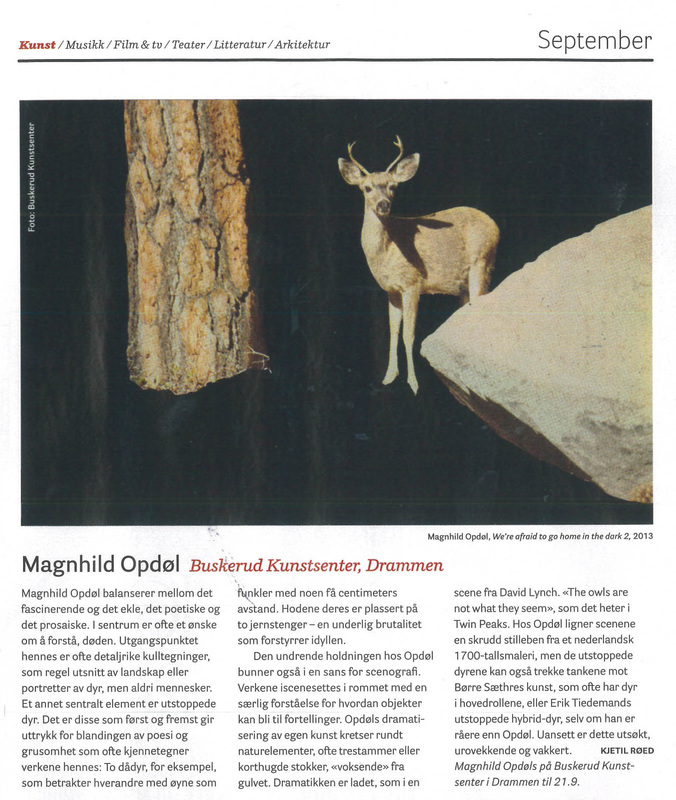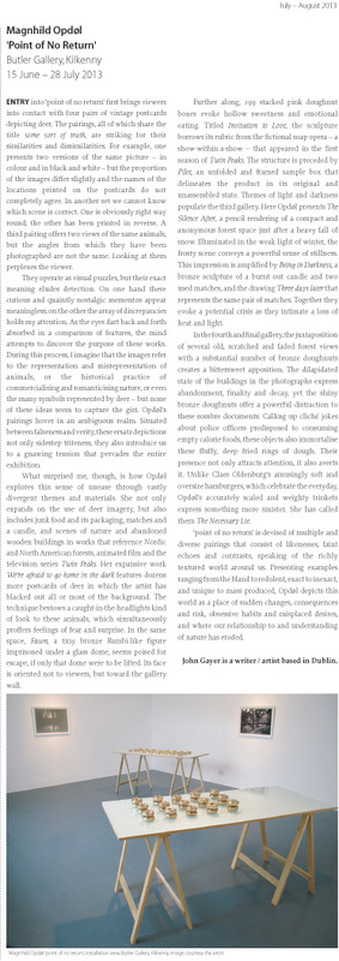|
|||||||
|
|
Kjetil Røed, Aftenposten K, September 2014.
Review by John Gayer, Visual Artists' News Sheet, July _August 2013.
point of no return Butler Gallery Magnhild Opdøl June 15 – July 28, 2013 The Butler Gallery is pleased to present an exhibition of new work by Norwegian artist Magnhild Opdøl. Opdøl's practice includes drawing, sculpture, photography and installation. The title of the show, point of no return relates to the point in a story when the plot has developed to the stage where you can only move forward with what you have. It is a fascination with things not being reversible, such as the depletion of our earth's natural resources, the extinction of species of animals, and the strangeness of a human race that keeps on ravaging the planet, while knowing they are the authors of their own destruction. Opdøl 'stirs' stories in us much more so than telling us stories, her works providing more a nudge in a direction rather than a narrative. Opdøl's references are quirky and diverse – from Walt Disney's Bambi and Pinocchio to David Lynch's cult TV series, Twin Peaks. In this exhibition, Opdøl makes a departure from the poetics of the dead and her customary use of taxidermy and detailed drawings of animals. Here, she alters a series of vintage postcards of deer, and by isolating the image of the deer in postcards that change from day to night, the same story seems to be repeated over and over. These intimate works beautifully convey the stillness and expectancy of the deer and the silence of the woods. It is as if they are preparing to leave nature behind to enter the darkness of an unknown future – a point of no return. The deer represents all animals to Magnhild Opdøl. It embodies the cuteness of Bambi, frozen in time in polished bronze, it can be used as a trophy, it provides food and clothing, it can be seen as wild or tame, it is elegant, and it can grow from a wobbly calf to a monumental stag. Dessert is serious business in Twin Peaks where Opdøl highlights the donut, the standard fare of the Twin Peaks' police department. Donuts and donut boxes, in this case pink boxes, represents consumerism at its most disposable. Opdøl enjoys the idea of making trophies out of trash, so here we will see 54 bronze donuts displayed including a minimalist tower of American pink donut boxes, which the artist will make and stack during a week-long installation at the Butler Gallery. Magnhild Opdøl is an enormously skilful artist that makes work that is deeply felt and thought- provoking. This exhibition, which is full of new ideas and ways of working, is humorous, dark and beautiful. The work offers us a glimpse of a moment in time just passed, or of a stillness caught in time. These new works draw us into a storytelling space, where the story has been frozen for us to take a walk around to explore and remember. Magnhild Opdøl was born in Sunndalsøra, Norway in 1980. She lives and works in Dublin and Ålvundeid, Norway. Opdøl received a B.A. in Fine Art in 2004 and an MA in Fine Art Painting in 2007 from the National College of Art and Design, Dublin. She has exhibited widely both in Ireland and internationally and has been the recipient of many important awards and residencies. Magnhild Opdøl was the first recipient of The Tony O’Malley Residency in Callan, Kilkenny. Solo exhibitions follow at Akershus Kunstsenter, Norway this August and The West Cork Arts Centre in November 2013. Meet the Artist Thursday 27 June at 1pm With grateful thanks to the Arts Council for essential annual funding and to the OPW, FÁS and Kilkenny Local Authorities for additional assistance. Butler Gallery, The Castle, Kilkenny, Ireland t: + 353 56 776 1106 e: info@butlergallery.com w:www.butlergallery.com Dead Dog Farm Galway Arts Centre 7 - 29 October 2011 “Of all the people in the world the best and the worst are drawn to a dead dog. Most turn away. Only those with the purest of heart can feel its pain and somewhere in between the rest of us struggle.” For her solo exhibition in Galway Arts Centre Magnhild Opdøl uses the starting point of the popular 1990’s ABC TV series Twin Peaks. Her own hometown Sunndalsøra is a friendship town of Twin Peaks. The programme explores doubles, good, evil and the murky layers in between. Opdøl searches for similarities in her home, a place at once very familiar and unknown. Her art practice has been occupied with the poetics of the dead and our aversion to images of decay. In the original publicity for Twin Peaks, co-creator David Lynch’s now iconic image of a dead Laura Palmer featured on magazine covers, billboards and posters. The character of Laura Palmer starts as a two dimensional image and a stereotype for goodness and innocence, before the underbelly of the town is exposed through Special Agent Coopers investigations. Although Laura appears later on in the ‘Other Place’ and as her own cousin Maddie, she is never truly alive; in the minds of the viewer she is iconographic and stands for the loss of innocence, she is not a real person. Laura is a teenager that will never see adulthood or be able to disassociate herself from her traumatic childhood and adolescence. David Lynch speaks about the idea behind the series he co-created with Mark Frost: “Once you’re exposed to fearful things, and you see that really and truly many, many, many things are wrong – and so many people are participating in strange and horrible things – you begin to worry that the peaceful, happy life could vanish or be threatened.” Magnhild Opdøl’s work is also influenced by the early 17th Century Northern European tradition of Vanitas paintings, which used symbols of death to express the transience of life compared to the everlasting nature of faith. The term comes from “Vanitas vanitatum omnia vanitas” which is translated in the King James Bible as “Vanity of vanities; all is vanity”and “Utterly meaningless, everything is meaningless” by the new International Version of the Bible. The objects featured in these works included skulls, decaying and / or bitter fruit, bubbles, hourglasses, smoke. They were strangely alluring while at the same time affirming our mortality and transience. A viewer of Opdøl’s ‘Dead Dog Farm’ in Galway Arts Centre first encounters ‘First Circle’, a taxidermied lamb and ‘Confabulation III’ a photograph of the lamb in a field. The lamb is innocent yet has an Uncanny quality. It is viewing its own Doppelgänger. There is confusion over what is real and what isn’t. Is the lamb less real now that he is dead? A mounted log over the fireplace is a direct reference to Twin Peaks’ ‘Log Lady’. The log is cradled by a gun holder, a common object in Norway and in Twin Peaks. Aside from their thematic connotations, there is a strange joining of materials that make up this sculptural object. For this exhibition Opdøl has moved into video work also. We encounter a large projection of a domestic cat eating a bird. This piece was made with a conscientious nod to Fischli and Weiss’ Büsi (Kitty) (2001, SFMOMA). However where the Swiss duo’s cat is peacefully taking a break and enjoying a drink, Opdøl’s subject is getting pleasure from eating a bird. This immediately conjures feelings of disgust and horror, but is it any different from walking past a restaurant window and seeing somebody eating chicken? Do we create rules and regulations for ourselves in order to separate what is good and what is bad? The front room of GAC’s gallery 2 depicts a ‘crime scene’ where deer hunting has taken place. We also see the image of a house, strangely symmetrical and visually attractive. Is this Dead Dog Farm? We see plastic on the ground – linking us back to the icon of Laura Palmer wrapped in plastic. There is a sinister, cold edge to these works, emphasized by the cold and harsh lighting. The series suggests that time has passed: something has happened and has not been resolved. It seems that the longer the human race exists, the more afraid it is of dying. We have never had more knowledge: we are rational beings. However an image of pain, death and decay still fills us with an abject feeling. There is a very thin line between life and death. There is no line at all between goodness and badness. We kill animals to eat them but do not expect to either see the carcasses or in the case of the cat, see another animal doing the same as us. The title, ‘Dead Dog Farm’ conjures a horrific image in our head. We are then confronted with beautifully rendered drawings of dead animals in gallery 1. Death is not something to be afraid of; it is something that can, like the case of Laura Palmer, ignite action in a place and reveal the truth in everything and everyone that revolves around it. Maeve Mulrennan |
||||||
|
|
|||||||


